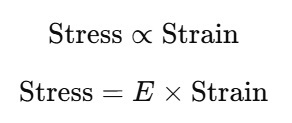ncert solutions physics class 11th
Get insights from 152 questions on ncert solutions physics class 11th, answered by students, alumni, and experts. You may also ask and answer any question you like about ncert solutions physics class 11th
Follow Ask QuestionQuestions
Discussions
Active Users
Followers
New answer posted
8 months agoContributor-Level 10
Hooke's Law states that within the elastic limit, the stress applied to a material is directly proportional to the strain produced. Mathematically,
E stands for the modulus of elasticity also called Young's modulus in case of linear deformation.
The Hooke's Law defines the elastic behaviour of materials, determines its elastic limit and helps in material selection for construction and manufacturing. It is used to design springs and elastic components in machines. Hook's law is applicable for the solids within their elastic limit.
Hooke's law for a spring and other elastic material is shown as:
F is the force applied on the mat
New answer posted
8 months agoContributor-Level 10
Rolling motion is a combination of rotational and translation motion where an object moves forward while spinning around an axis. An example is a rolling wheel. The equation for rolling motion without slipping is:
v represents the linear velocity, r is the radius and w stands for the angular velocity. Rolling motion is more complex than pure rotation as in this case every point on the object follows a curved trajectory whereas in pure rotation, the object only spins around a fixed axis without any change in its position.
New answer posted
8 months agoContributor-Level 10
Torque (? ) is used to measure the force that causes rotational motion. It is similar to how force causes linear motion. Newton's second law for rotational motion shows the relation between torque and angular acceleration.
I stand for the moment of inertia and a is the angular acceleration. According to this equation, the greater the torque applied to an object, the higher its angular acceleration. Moreover, the object with a larger I will require more torque to achieve the same angular acceleration.
New answer posted
11 months agoContributor-Level 10
General Category: A minimum of 45% aggregate marks in the Class 10 examination is generally required.
Reserved Categories: The requirement of percentage may be relaxed, and sometimes even the pass mark is considered enough, for candidates from reserved categories (SC/ST/OBC).
Additional Information
Admission is merit-based; however, the specific cutoff percentage varies from year to year depending on the number of applicants and their performance.
For precise details about cut off percentage this academic year and the latest updated one, always check out at the authentic Bhavan's College site or consult admissions office there.
Taking an Exam? Selecting a College?
Get authentic answers from experts, students and alumni that you won't find anywhere else
Sign Up on ShikshaOn Shiksha, get access to
- 66k Colleges
- 1.2k Exams
- 680k Reviews
- 1800k Answers




